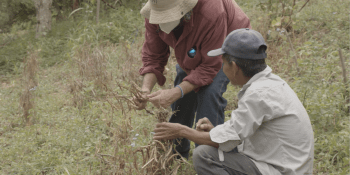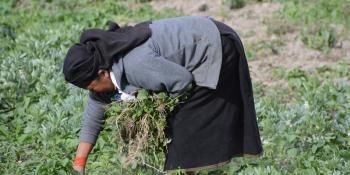Turning down Colombia's gas

Improved water management practices in rice and feeding cattle more cassava could help reduce methane emissions from agriculture, a new study shows.
Improved water management practices can reduce methane (CH4) emissions in rice crops, while switching some of the classical feed for livestock with cassava can help reduce methane emissions in cattle, according to a recent study led by the International Center for Tropical Agriculture (CIAT) and the CGIAR Research Program on Climate Change, Agriculture and Food Security (CCAFS). The study was published in the journal Sustainability.
Methane is a significantly potent greenhouse gas, absorbing more energy than carbon dioxide, which gives it a higher global warming potential.
Researchers focused on technology and management options that make agriculture more efficient and sustainable while cutting methane emissions. They looked at how alternate wetting and drying (AWD) – a type of irrigation that periodically dries and re-floods rice fields – reduces methane emissions in rice crops, as well as at how can women help in adopting new water management techniques.
Data from 2015 and 2016 reveals major differences between CH4 emission levels in completely flooded fields versus crops subjected to AWD: 7.54 kg versus 2.28 kg (2015) and 19.50 kg versus 5.28 (2016). The results are in line with similar research saying that AWD can cut CH4 emissions by 65 to 73%.
One potential downside of using AWD could be increasing nitrous oxide (N2O) emissions, which can offset about 15-20% of the gain in reducing CH4. Nitrous oxide has a GWP 265–298 times that of CO2 for a 100-year timescale and can remain in the atmosphere for more than a century, according to the US Environmental Protection Agency. The switch between wet and dry conditions favors bacterial activity that turns various nitrogen compounds into nitrous oxide that is then released from the soil. But combining AWD with efficient nitrogen use (keeping careful track of fertilizer amounts) can offset these emissions.
“You are still better off reducing CH4 through AWD, even when slightly increasing N2O,” says Ngoni Chirinda, soil scientist at CIAT and the study’s lead author.

Improving water and fertlizer management of rice fields has high potential to reduce methane emissions. Photo: N. Palmer (CIAT)
Payments for water are not usage-dependent so there are no real incentives to save water, the experts point out. Technological solutions, as appealing as they appear on paper, need to be applied in the right context to work and not burden farmers. Currently, women are not acknowledged enough for their critical role in rice production and innovation without shifting the gender bias threatens to bring up more work for them. At the same time, results show women farmers have a higher tendency to preserve water resources and reduce emissions.
Adoption of AWD remains limited as:
- Farmers are insufficiently aware of the options available to them;
- There is still much reluctance in taking risks with techniques that have not proven effective in the local context; and
- Policy incentives for risk taking are still lacking.
The researchers propose:
- Better identifying where these solutions are needed, through soil mapping, rice statistics and climate data;
- Targeting the correct actors to reduce the risk of further burdening their work; and
- Improving policies to encourage saving resources.
Enteric fermentation is the largest human-induced source of methane. In Colombia, methane emissions are produced mainly by livestock (19% of national GHG emissions), while agriculture overall generates about 47.5% of total CH4 emissions.
Cutting the amount of methane cattle produce can involve introducing more cassava leaves into their diet. Cassava contains a high quantity of tannins which reduce gas production by diminishing fiber digestion, which could bring down emissions from 22% to 55%, according to the researchers.
Results show that tropical grass-based diets supplemented with cassava can represent a significant feed especially during dry conditions, with “low methane production compared to diets based on tropical grasses alone.”
Still, this remain a tough-to-chew issue. Literally. Research has showed that cassava can turn out heavy on cattle digestive system, but a lower intake of the leaves could make it a safe source of feed. Pruning cassava to increase its digestibility is a solution that needs further exploration, highlights the study. Researchers are currently measuring emissions from mixed diets of cassava and Brachiaria humidicola, a common grass used as forage across the tropics.
Researchers also looked at the sociological implications of climate change mitigation in agriculture. Taking into consideration women’s labor in the livestock sector is critical – they are heavily involved in managing pastures, animal rearing, meat and dairy processing, as well as selling end products. The study calls for evaluating how any new solutions might disturb the amount of work they need to put in. It also pleads for changing the paradigm around agricultural systems and looking beyond efficiency, on how can those systems not only produce more but improve economic, ecological and social outcomes.
There are no silver bullets. Having producers involved in evaluating mitigation tools provides important insights into where is best to apply them, what works and what doesn’t. Involving farmers in designing and implementing climate-smart agriculture techniques is central for reducing emissions at local level and ensuring sustainability.
Read more:
Chirinda N, Arenas L, Loaiza S, Trujillo C, Katto M, Chaparro P, Nuñez J, Arango J, Martinez-Baron D, Loboguerrero AM, Becerra Lopez-Lavalle LA, Avila I, Guzmán M, Peters M, Twyman J, García M, Serna L, Escobar D, Arora D, Tapasco J, Mazabel L, Correa F, Ishitani M, Da Silva M, Graterol E, Jaramillo S, Pinto A, Zuluaga A, Lozano N, Byrnes R, LaHue G, Alvarez C, Rao I, Barahona R. 2017. Novel Technological and Management Options for Accelerating Transformational Changes in Rice and Livestock Systems. Sustainability 9(11):1891.
Researchers conducted surveys across 609 households in Tolima, Norte de Santander, Cordoba, Cesar and Casanare departments, representing about 10% of total farmers growing irrigated rice. The field study was conducted during two cropping seasons at the FEDEARROZ experimental station in Saldana, Tolima.
Errata: This story has been further edited for accuracy.
Alexandra Popescu is the Communications officer for CCAFS Latin America.



